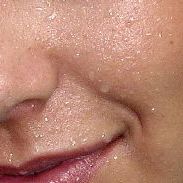Diaphoresis
| Perspiration | |
|---|---|
 |
|
| Droplets of perspiration on the skin | |
| Classification and external resources | |
| Specialty | Dermatology |
| MedlinePlus | 003218 |
| MeSH | D013546 |
Perspiration, also known as sweating or diaphoresis, is the production of fluids secreted by the sweat glands in the skin of mammals.
Two types of sweat glands can be found in humans: eccrine glands and apocrine glands. The eccrine sweat glands are distributed over much of the body.
In humans, sweating is primarily a means of thermoregulation, which is achieved by the water-rich secretion of the eccrine glands. Maximum sweat rates of an adult can be up to 2–4 liters per hour or 10–14 liters per day (10–15 g/min·m²), but is less in children prior to puberty.Evaporation of sweat from the skin surface has a cooling effect due to evaporative cooling. Hence, in hot weather, or when the individual's muscles heat up due to exertion, more sweat is produced. Animals with few sweat glands, such as dogs, accomplish similar temperature regulation results by panting, which evaporates water from the moist lining of the oral cavity and pharynx.
Primates and horses have armpits that sweat like those of humans. Although sweating is found in a wide variety of mammals, relatively few (exceptions include humans and horses) produce large amounts of sweat in order to cool down.
Sweat contributes to body odor when it is metabolized by beneficial bacteria on the skin. Medications that are used for other treatments and diet also affect odor. Some medical conditions, such as kidney failure and diabetic ketoacidosis, can also affect sweat odor. Areas that produce excessive sweat usually appear pink or white, but, in severe cases, may appear cracked, scaly, and soft.
...
Wikipedia
